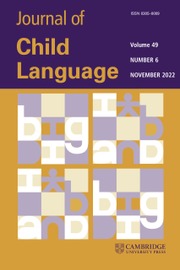Crossref Citations
This article has been cited by the following publications. This list is generated based on data provided by Crossref.
Gullberg, Marianne
Hendriks, Henriëtte
and
Hickmann, Maya
2008.
Learning to talk and gesture about motion in French.
First Language,
Vol. 28,
Issue. 2,
p.
200.
Guidetti, Michèle
and
Nicoladis, Elena
2008.
Introduction to Special Issue: Gestures and communicative development.
First Language,
Vol. 28,
Issue. 2,
p.
107.
Colletta, Jean-Marc
Kunene, Ramona N.
Venouil, Aurélie
Kaufmann, Virginie
and
Simon, Jean-Pascal
2009.
Multimodal Corpora.
Vol. 5509,
Issue. ,
p.
54.
Gullberg, Marianne
2009.
Gestures and the development of semantic representations in first and second language acquisition.
Acquisition et interaction en langue étrangère,
p.
117.
Stefanini, Silvia
Bello, Arianna
Caselli, Maria Cristina
Iverson, Jana M.
and
Volterra, Virginia
2009.
Co-speech gestures in a naming task: Developmental data.
Language and Cognitive Processes,
Vol. 24,
Issue. 2,
p.
168.
Gullberg, Marianne
and
Narasimhan, Bhuvana
2010.
What gestures reveal about how semantic distinctions develop in Dutch children's placement verbs.
Cognitive Linguistics,
Vol. 21,
Issue. 2,
Marentette, Paula
and
Nicoladis, Elena
2011.
Preschoolers’ interpretations of gesture: Label or action associate?.
Cognition,
Vol. 121,
Issue. 3,
p.
386.
Andonova, Elena
and
Taylor, Holly A.
2012.
Nodding in dis/agreement: a tale of two cultures.
Cognitive Processing,
Vol. 13,
Issue. S1,
p.
79.
Fusaro, Maria
Harris, Paul L
and
Pan, Barbara A
2012.
Head nodding and head shaking gestures in children’s early communication.
First Language,
Vol. 32,
Issue. 4,
p.
439.
Gullberg, Marianne
2012.
The Handbook of Bilingualism and Multilingualism.
p.
417.
Kettner, Viktoria A.
and
Carpendale, Jeremy I.M.
2013.
Developing gestures fornoandyes.
Gesture,
Vol. 13,
Issue. 2,
p.
193.
Barthélémy-Musso, A.
Tartas, V.
and
Guidetti, M.
2013.
Prendre les objets et leurs usages au sérieux : approche développementale de la co-construction de conventions sémiotiques entre enfants.
Psychologie Française,
Vol. 58,
Issue. 1,
p.
67.
Benazzo, Sandra
and
Morgenstern, Aliyah
2014.
A bilingual child’s multimodal path into negation.
Gesture,
Vol. 14,
Issue. 2,
p.
171.
Andrén, Mats
2014.
Multimodal constructions in children.
Gesture,
Vol. 14,
Issue. 2,
p.
141.
Fusaro, Maria
Vallotton, Claire D.
and
Harris, Paul L.
2014.
Beside the point: Mothers’ head nodding and shaking gestures during parent–child play.
Infant Behavior and Development,
Vol. 37,
Issue. 2,
p.
235.
Guidetti, Michèle
Fibigerová, Kateřina
and
Colletta, Jean-Marc
2014.
From Gesture in Conversation to Visible Action as Utterance.
p.
351.
COLLETTA, JEAN-MARC
GUIDETTI, MICHÈLE
CAPIRCI, OLGA
CRISTILLI, CARLA
DEMIR, OZLEM ECE
KUNENE-NICOLAS, RAMONA N.
and
LEVINE, SUSAN
2015.
Effects of age and language on co-speech gesture production: an investigation of French, American, and Italian children's narratives.
Journal of Child Language,
Vol. 42,
Issue. 1,
p.
122.
Beaupoil-Hourdel, Pauline
Morgenstern, Aliyah
and
Boutet, Dominique
2016.
Negation and Polarity: Experimental Perspectives.
Vol. 1,
Issue. ,
p.
95.
Cochet, Hélène
and
Byrne, Richard W.
2016.
Communication in the second and third year of life: Relationships between nonverbal social skills and language.
Infant Behavior and Development,
Vol. 44,
Issue. ,
p.
189.
Hübscher, Iris
Esteve-Gibert, Núria
Igualada, Alfonso
and
Prieto, Pilar
2017.
Intonation and gesture as bootstrapping devices in speaker uncertainty.
First Language,
Vol. 37,
Issue. 1,
p.
24.

